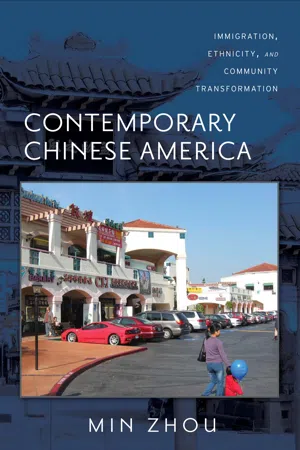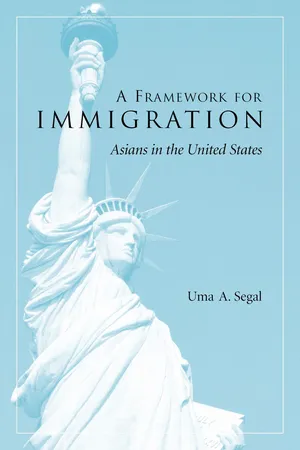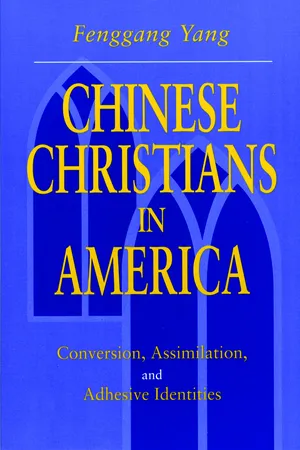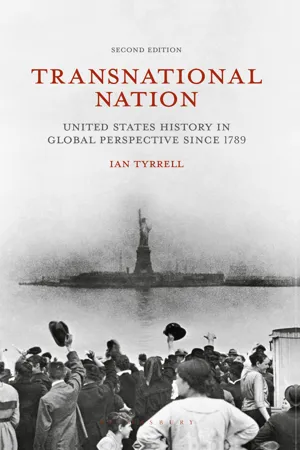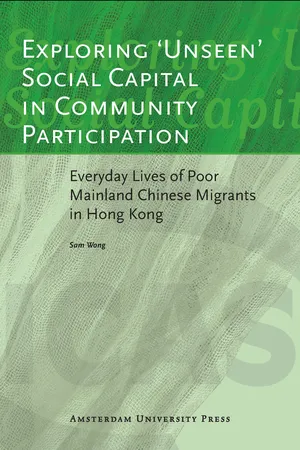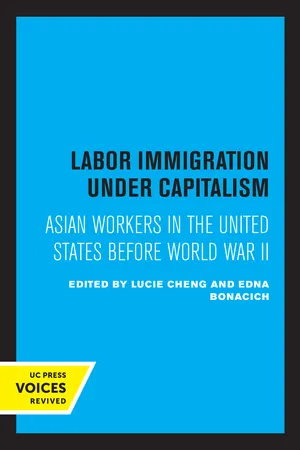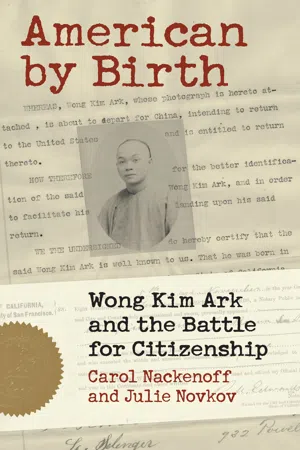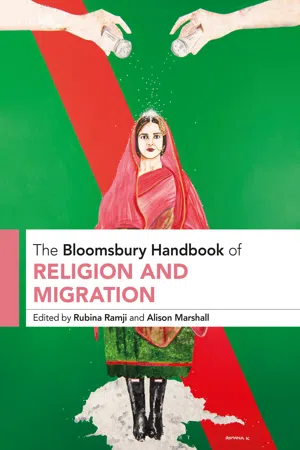History
Chinese Immigration
Chinese immigration refers to the movement of Chinese people to other countries, particularly during the 19th and 20th centuries. This migration was driven by factors such as economic opportunities, political instability, and the search for a better life. Chinese immigrants faced significant challenges, including discrimination and restrictive immigration policies, but they also made valuable contributions to the societies where they settled.
Written by Perlego with AI-assistance
Related key terms
1 of 5
10 Key excerpts on "Chinese Immigration"
- Available until 19 Nov |Learn more
Contemporary Chinese America
Immigration, Ethnicity, and Community Transformation
- Min Zhou(Author)
- 2009(Publication Date)
- Temple University Press(Publisher)
I Historical and Global Contexts 1 The Chinese Diaspora and International Migration C hinese America is a part of the Greater Chinese Diaspora. Interna-tional migration among Chinese people is centuries old: long before European colonists set foot on the Asian continent, the Chinese moved across sea and land, seasonally or permanently, to other parts of Asia and the rest of the world to earn a living and support their families. In this chapter I offer a historical overview of Chinese emigration as a basis for understanding contemporary Chinese Immigration to the United States. History has witnessed distinct patterns of emigration from China to the outside world and from Chinese diasporic communities to other countries. 1 About 35 million overseas Chinese ( huaqiao 华侨 ) and people of Chinese ancestry ( huayi 华裔 ) live outside mainland China (including Hong Kong and Macao) and Taiwan. 2 People of Chinese ancestry have spread across the globe to more than 150 countries: over 80 percent in Asia (approximately 75 percent of the total in Southeast Asia) and about 13 percent in the Americas. 3 In the mid-1990s, countries with the largest number of people with Chinese ancestry included Indonesia (7.3 million), Thailand (6.4 million), Malaysia (5.5 million), Singapore (2.3 million), and the United States (2.7 million). 4 The extent of the Chinese Diaspora is captured in an old saying: “There are Chinese people wherever the ocean waves touch.” 5 How do the centuries-old Diaspora and its longstanding migrant net-works interact with broader structural factors: colonization, decoloniza-tion, nation-state building, and changes in political regimes? In order to map the courses and patterns of international migration, I first provide a his-torical analysis of Chinese emigration and then discuss the implications of 24 / Chapter 1 contemporary Chinese migration for both countries of origin and countries of destination. - Available until 27 Jan |Learn more
A Framework for Immigration
Asians in the United States
- Uma A. Segal(Author)
- 2002(Publication Date)
- Columbia University Press(Publisher)
What binds all emigrants is the awareness that certain needs can be better filled outside their coun-tries of origin. Immigration theorists write of the push and pull in the emigration-immigration process. The “push” comprises the factors, which may be 38 environmental or intrapersonal, that fuel an individual’s discontent. The “pull” from another nation may exacerbate that discontent. While personal stories humanize Asian immigration to the United States, it is clear that there have been waves of exodus to the United States from different Asian nations since the 1850s, and the emigration of these people has been the result of a combination of historical social-political-economic conditions in their home countries. These have been bal-anced by the then contemporary social-political-economic climate in the United States and perceptions of Asians among U.S. nationals. During specific periods in the history of the United States, groups of immigrants from various Asian nations have entered the country. While U.S. immigration policy and economic needs have greatly de-fined immigration patterns, the primary impetus for emigration has usually been conditions in the home country and the individual’s dis-cernment of options within them. Thus, to place Asian immigration to the United States in context, it may be useful to review the events and the climate in the country of emigration during particular immigration waves. As historians underscore, a significant connection often exists between the past and the present (Nehru 1946). CHINESE EMIGRATION: 1848–1882 An Overview of the Nation’s History Chinese history dates back to the twenty-first century b.c. Through the centuries, a distinctly Chinese civilization emerged with a unique philosophy, language, writing, and art, and it has persisted to the pres-ent. - eBook - PDF
Chinese Christians in America
Conversion, Assimilation, and Adhesive Identities
- Fenggang Yang(Author)
- 1999(Publication Date)
- Penn State University Press(Publisher)
2 Chinese Immigrants, Cultural Traditions, and Changing Identities Chinese Immigration to the United States has a history of about one and a half centuries. Until World War II, Chinese were unwelcome immigrants and were deprived of the right to become American citizens. Since the 1960s, however, Chinese immigrants have come in large numbers from diverse societies, including Taiwan, Hong Kong, the People’s Republic of China, and Southeast Asian countries. Meanwhile, the American public has come to perceive Chinese-Americans as a successful or “model minority.” In the same period of the last one and a half centuries, China has been full of wars, revolutions, social turmoil, and natural disasters, which have pushed many people to emigrate. Chinese cultural traditions have received devastating attacks by Chinese intellectuals and political elites for the sake of modernizing China. Consequently, the meaning of Chineseness has significantly changed. Within these social, cultural, and historical contexts, Chinese immigrants struggle to construct and reconstruct their identities. To understand the identity construction of Chinese Christians in America, this chapter provides a brief review of Chinese Immigration and ethnic Chinese organizations, Chinese cultural traditions and their predicaments in modern times, and changing identities among Chinese in the diaspora. Chinese Immigrants Chinese immigrants began to arrive in the United States in large numbers in the late 1840s, but the Chinese-American population began to grow Chinese Immigrants and Changing Identities 35 significantly only after the 1960s. According to the U.S. census, the Chinese constitute the largest Asian-American population, numbering 1,654,472 in 1990 (see Table 3). 1 During the years of the Chinese Exclusion Acts (1882–1943), which barred Chinese Immigration and naturalization, the Chinese population in the United States first decreased, then slowly grew. - eBook - PDF
Transnational Nation
United States History in Global Perspective since 1789
- Ian Tyrrell(Author)
- 2015(Publication Date)
- Red Globe Press(Publisher)
With China also drawn more into a world economy in which the need for labour mobility was becoming apparent, the 1850s to 1870s – during the first wave – saw substantial Chinese labour that resembled more closely the second-wave European immigration in class composition migrate to the west coast of the United States. These Asian immigrants moved east instead of west, going as far as the Massachusetts town of North Adams where a shoe-factory owner imported them as strike-breakers, though more commonly they spread to such states as Oregon, Washington and Nevada. Congress largely eliminated Chinese Immigration as a political and cultural issue through the Chinese Exclusion Act of 1882 because, while the act specifically excluded ‘labourers’ only, the category was very broadly interpreted. But the Asian labour threat persisted in the form of the Japanese until 1908 when that in turn was restricted. At the same time, Mexican and other Hispanic immi-grants began to move north of the border. Truly the old model of a unidi-rectional flow across the Atlantic will not work any better than first- and People in Motion: Nineteenth-Century Migration Experiences 65 second-wave theory, because trans-Pacific and Latin American migration were also important. The contrast between geographically restless, mobile Americans and a static, sedentary European population cannot be maintained either. The United States became known in the nineteenth century as a nation of mov-ers. Small islands of what historians Peter Knights and Stephan Thernstrom called the persisting group – the prosperous residents who formed the back-bone of communities – stood proud and highly visible amid a seething tide of migrating manual workers, farmers and assorted people on the make. 8 High rates of geographical mobility occurred not only in frontier districts, but also in Eastern cities, where migrants swelled the ranks of the transient. - eBook - PDF
Chinese American Voices
From the Gold Rush to the Present
- Judy Yung, Gordon Chang, Him Mark Lai, Judy Yung, Gordon Chang, Him Mark Lai(Authors)
- 2006(Publication Date)
- University of California Press(Publisher)
part one Early Chinese Immigrants, 1852–1904 T he first Chinese to immigrate to the United States in the mid–-nineteenth century came principally from the Pearl River Delta of Guangdong Province in southeastern China. Attracted by stories of the California gold rush, they came not only as miner-prospectors, but also as artisans, merchants, and students. Many more arrived as laborers to work in Hawaii’s plantations and the mines, railroad lines, farmlands, fisheries, and factories of the American West. From 1852 until 1882, when the Chi-nese Exclusion Act was passed, over 300,000 Chinese entered the United States. They were part of an international migration of labor from Asia linked to the global expansion of European capitalism, in which workers, capital, and technology moved across national borders to profit entrepreneurs. After China was defeated in the Opium War by Britain and forced to open to outside trade and political domination, life for the Chinese people in Guang-dong Province deteriorated. Aside from suffering increased taxes, forfeiture of land, competition from imported manufactured goods, and unemploy-ment, they also had to contend with problems of overpopulation, natural calamities, bandits, and the devastation caused by peasant rebellions and the ongoing Punti-Hakka interethnic feud. Because of their coastal location and their early contact with foreign traders, many were drawn to America by news of the gold rush and by labor contractors in search of young, able-bodied men to work in the New World. Moreover, a strong entrepreneurial tradi-tion had emerged among some of the Chinese in this region, causing them to seek new opportunities abroad. By the latter part of the nineteenth cen-tury, emigration patterns were firmly established, and many villages in the Pearl River Delta came to depend on the remittances of men who had gone overseas for work. Like other immigrants in America at this time, many of these Guangdong 1 - eBook - PDF
Exploring 'Unseen' Social Capital in Community Participation
Everyday Lives of Poor Mainland Chinese Migrants in Hong Kong
- Sam Wong(Author)
- 2007(Publication Date)
- Amsterdam University Press(Publisher)
3 Historical and Cultural Contexts of Mainland Chinese Migrants in Hong Kong 3.1 Introduction Hong Kong is generally regarded as ‘a city of immigrants’ which sug-gests that the history of Hong Kong is largely one of migration (e.g., Choi 2001). While this popular discourse highlights the fact that mi-gration is not a new phenomenon in Hong Kong and emphasises the role of migrants in the host society, it bears the risk of oversimplifying the complex processes of resettlement over time and denying the mi-grants’ subjectivity and the diverse migration experiences of different generations. This complexity is manifest in the need to change what we call migrants, from ‘refugees’, and ‘immigrants’ to ‘new arrivals’ in the government documents and from ‘ Ah Chann ’ (literally, uneducated people) to ‘ Dai Luk Por ’ (a derogatory term for mainland women, im-plying lower status) in the media. The on-going and shifting debates about the role of migrants as economic assets and/or social burdens re-flect the fact that ‘migrants’ is a very politically charged term. This chapter is split into two sections. The first section will locate the mainland Chinese migrants historically. This historical account of migrants does not merely focus on the migrants themselves, but on the political, economic, and social settings all around them. I divide Hong Kong history into five phases since 1945, so I can examine the changing immigration policies, political situations, both in China and Hong Kong and both before and after colonial rule, and from the per-spective of the internal and external economic environment. The em-phasis will be on changing government policies from that of minimal intervention to that of social capital building and the roles of develop-ment agencies and local organisations in mobilising migrants to be-come involved in community development. - eBook - PDF
Labor Immigration under Capitalism
Asian Workers in the United States Before World War II
- Lucie Cheng, Edna Bonacich, Lucie Cheng, Edna Bonacich(Authors)
- 2023(Publication Date)
- University of California Press(Publisher)
It is highly significant that foreign powers and their Chinese agents took an active role in promoting emigration. This characteristic is unique to nineteenth century Chinese emigration and sets it apart from the other waves of emigration in Chinese history. Previous Chinese expedi- tions to Korea, Vietnam, and central Asia were a result of deliberate military expansion. Although they resulted in the appearance of sizable Chinese populations in other countries, their purpose was conquest and settlement, undertaken at the initiative of the Chinese government. T h a t is, they were created entirely by internal factors. 2 T h e best-known instances of Chinese emigration before the nine- teenth century were the exoduses to southeast Asia, the Philippines, and Indonesia, which took place during the collapse of the Ming dynasty Although these moves were largely prompted by political unrest and economic chaos at h o m e (all internal factors), they still represented an 222 Imperialism, Distorted Development, and Asian Immigration to the U.S. emigration of settlers and colonizers. T h e s e people were not being employed by anyone, nor were they entering a structured econorry. T h e r e was no distinction between their persons and their labor power. While the exact details are unclear, it seems quite unlikely that this wave of emigration became a business, if only because the turiroil and strife in China was too extensive to allow this to happen. Certair.ly the emigrants were not induced by any foreigners to leave China in this period. O n c e abroad, they generally controlled their o w n econo- mies, whereas in the nineteenth century, Chinese laborers usually worked in enterprises or on land owned or planned by others. Finally, because the earlier emigrants were moving to relatively underdevelopsd countries, they were able to become dominant economic forces in their communities. - eBook - ePub
American by Birth
Wong Kim Ark and the Battle for Citizenship
- Carol Nackenoff, Julie Novkov, Carl Nackenoff(Authors)
- 2021(Publication Date)
- University Press of Kansas(Publisher)
22Chinese immigrants and their descendants retained close connections with their homes. Those who were successful remitted funds home, but many also used their wealth to lend funds to other individuals from their home districts who were hoping to emigrate. Prospective emigrants turned to local kin networks for advice and loans as well.23 The wave of immigration was “a movement of unmarried men” who sought to build up the funds during their sojourns to support a family in their home villages.24Another factor in migration was the formation of huiguan , or associations linking people from the same region who were sojourning together far away, in California. In 1862 , six such associations became a federation known unofficially to Americans as the Chinese Six Companies.25 In San Francisco, the Six Companies built houses and temples and established a mutual aid society that provided everything from short-term financial help to dispute resolution services. Chinese seeking to leave Guangdong Province knew that they could begin to rely on kin assistance from these networks even before they entered the United States if they came in through the port of San Francisco. The Six Companies also kept careful records of Chinese not just in San Francisco but across the entire United States.26The initial influx of Chinese to California in particular had a dramatic effect. Thirty-five thousand Chinese migrated to California between 1848 and 1852 , swelling the sparsely settled new state to the point that “they constituted at least 10 percent of the population during the 1850 s.”27 By 1860 , the Chinese had become the largest foreign-born ethnic group in the state.28 Some of these early migrants were merchants, eager to establish themselves as traders and importers in San Francisco in the wake of economic recessions in Canton.29 Many more, however, were laborers. While labeled “coolies” by many Americans, this was not strictly correct: most male emigrants bound for the United States wanted to come and were not kidnapped or coerced.30 They were not, however, completely free and independent upon arriving in the United States. They tended to borrow the funds needed to secure passage, agreeing to pay back their brokers with interest from the wages earned when they arrived and established themselves.31 They were strongly and at times illegitimately enticed by the shipping firms enriched by their transit and the economic interests in the United States that would benefit by paying their significantly lower wages. Many men dreamed of coming to the United States and returning to China with enough resources to fund a comfortable life for themselves and their families, but of the more than two hundred thousand who had come by the late 1870 s, only about a quarter returned to stay in China.32 - eBook - PDF
Chinese American Transnationalism
The Flow of People, Resources
- Sucheng Chan(Author)
- 2005(Publication Date)
- Temple University Press(Publisher)
Economically motivated immigrants encountered strong anti-Chinese ideologies that prevailed in America’s political and Understanding Chinese American Transnationalism 159 socioeconomic landscapes. Racism took away the immigrants’ fundamen-tal political and social rights and was the most serious obstacle they en-countered as they tried to achieve their economic goals. The infamous 1882 Chinese Exclusion Act suspended the immigration of laborers and stipulated that Chinese immigrants could not become naturalized citizens because they were not white, a stipulation that goes back to the 1790 Naturalization Act. By the early twentieth century, the ban on Chinese la-bor immigration became permanent. Anti-Chinese racism was also cod-ified at the state and local levels. In California, for example, the 1913 Alien Land Law prohibited aliens who could not become naturalized U.S. citizens—a definition that included Chinese immigrants—to own land. Chinese were also not allowed to marry whites. Prejudice and violent ri-ots drove Chinese away from rural areas and from manufacturing jobs. Increasingly concentrated mostly in a few urban settlements, such as New York, San Francisco, and Chicago, Chinese Americans found themselves employed increasingly in only a small number of service industries with the exception of San Francisco. Consequently, racism created dreadful constraints on the transnational world of Chinese Americans by severely limiting the flow of goods, capital, and people across the Pacific Ocean. Those who traveled to China for visits faced the risk of losing their right to reenter the United States. 9 However, Chinese immigrants never remained passive victims of dis-crimination. They fought for their rights within the American legal and political arenas and even won a few significant battles. - Rubina Ramji, Alison Marshall(Authors)
- 2022(Publication Date)
- Bloomsbury Academic(Publisher)
CHAPTER 15 Religion, migration and the Chinese in diaspora TAN CHEE-BENG Migration has been an essential part of human history. Studies on regional and trans-global migration have analysed the factors which influence migration, the roles of natural disasters and war, economic and political factors, as well as migrants’ adaptation, connection with homeland and issues of belonging (cf. Hoerder 2012; Wang 1997). There are fewer comprehensive studies on religion and migration, although some scholars have analysed the role of the church in helping migrants to adjust to Christian-dominant societies. This chapter discusses religion and migration with regard to Chinese migrants and their descendants. Religion provides hope to people and helps them to cope with uncertainty. Migrants, no doubt, pray to their God or deities for safe journeys and ease in settling down to a new livelihood in the new lands. Religion links migrants to their history and their sense of belonging, or to borrow the words of Emile Durkheim, it allows people to ‘become conscious of themselves and their history’ (Durkheim 1958: 160). The significance of religion to migration is best expressed by Thomas A. Tweed in his definition of religion: ‘Religions are confluences of organic-cultural flows that intensify joy and confront suffering by drawing on human and supernatural forces to make homes and cross boundaries’ (Tweed 2006: 54). Religion is thus part and parcel of the migration process and making home in alien lands. This chapter shows that religion also provides communal functions, helping Chinese migrants to organize and establish communities in new lands. 236 BLOOMSBURY HANDBOOK OF RELIGION AND MIGRATION RELIGIONS IN CHINA The People’s Republic of China (PRC) classifies its population into fifty-six minzu or ethnic categories, of which the Han people make up 92 per cent ( https://en .wikipedia .org /wiki /Sixth _National _Population _Census _of _the _People%27s_Republic_of_China).
Index pages curate the most relevant extracts from our library of academic textbooks. They’ve been created using an in-house natural language model (NLM), each adding context and meaning to key research topics.
